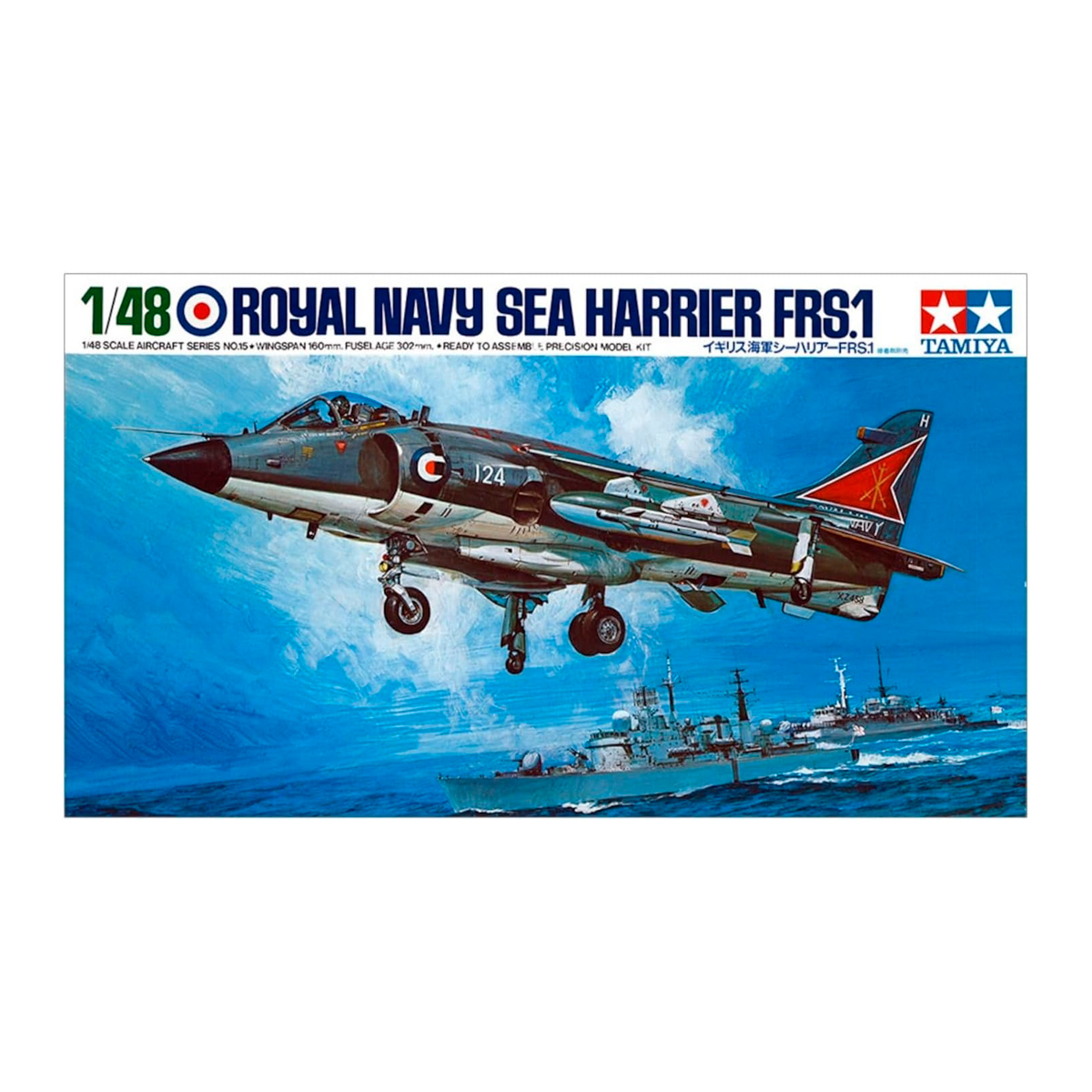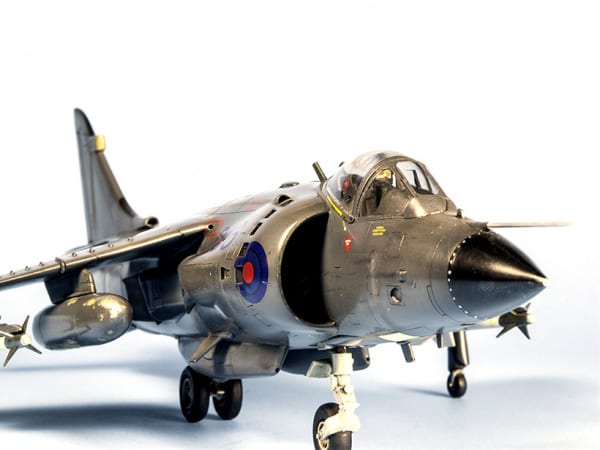1/48 Royal Navy Sea Harrier FRS.1
11,95€
In stock

*Please check our Privacy Policies to see how to we use your personal data.
*Por favor revisa nuestra Política de Privacidad para ver como tratamos tus datos personales
The Hawker Siddeley Harrier astounded the world with its unique ability to take-off and land vertically utilizing vectored thrust from its powerful 8000kg thrust engine. First tested in concept in 1960, the aircraft went through many periods of testing and modification prior to acceptance by the Royal Air Force and other nations in 1974. The production Harriers utilized either a Pegasus 6 or 11 engine of 8000 or 9750kg thrust and it was only natural that the Royal Navy should find application for this type of aircraft with their fleet air arm. Various political and financial considerations delayed the order for the “Navalized” Harrier until May 1975, when the Admiralty ordered an initial 24 aircraft plus one T.Mk.4’s in 1980.
The FRS.1 is easily distinguished from its land based counterparts by a modified nose section incorporating a raised pilots seat and Ferranti Blue Fox radar, plus principal armament of Sea Eagle anti-ship missiles and AIM-9L Sidewinder air-to-air missiles. Martel or Harpoon ASMs may be carried as alternatives to Sea Eagle until the latter become operational. The first FRS.1 to fly was actually the initial production Sea Harrier, on 20 August 1978, and the prototype model later in December 1978. The home of the Sea Harriers was designated Yeovilton Navy Base, and they received the first aircraft in June 1979, where intensive flight trials began with “100/VL” squadron four days later.
This IFTU unit was designated 700A squadron in September 1979 and was re-designated 899 Squadron in March 1980. Three “Through – Deck” cruisers had been ordered for Sea Harrier operations: Invincible; Illustrious and Ark Royal, the first of which was commissioned in July 1980. All three vessels are to be fitted with a “Ski-jump” to assist take-off with full load, and this installation was also added to the commando carrier HMS Hermes when it was allotted a Sea Harrier squadron. A small export order for Sea Harriers was placed by India in November 1979 for six FRS.51’s and two T.60 trainers.
The Sea Harrier, along with the GR3 Harriers from the RAF, were put to actual combat tests during the recent Falkland Islands crisis. The British South Atlantic force was built up with the addition of GR3 and FRS.1 Harriers bringing the total jump jet strength to around 40 aircraft carriers Hermes and Invincible. The Sea Harrier (FRS.1) has about 30% more re-action control for easier landings, and better “over the nose” visibility; however, the GR3’s from the RAF worked well in the overall operations during the conflict and both aircraft distinguished themselves to the utmost. The Royal Navy Harriers, during the conflict, were painted in the new “toned down” finish of matte sea blue overall, while the RAF aircraft were in the extra dark sea gray scheme. With a cruise speed of mach .9 and a top speed of 1.25, and landing speed of 0, this is truly a versatile combat aircraft and one that will be in weapons inventories for many years to come.
El Hawker Siddeley Harrier asombró al mundo con su capacidad única de despegar y aterrizar verticalmente utilizando el empuje vectorial de su potente motor de 8.000 kg. Probado por primera vez en 1960, el avión pasó por muchos periodos de pruebas y modificaciones antes de ser aceptado por la Royal Air Force y otras naciones en 1974. Los Harrier de producción utilizaban un motor Pegasus 6 u 11 de 8.000 o 9.750 kg de empuje y era natural que la Royal Navy encontrara una aplicación para este tipo de avión en su flota aérea. Diversas consideraciones políticas y financieras retrasaron el pedido del Harrier “navalizado” hasta mayo de 1975, cuando el Almirantazgo encargó un número inicial de 24 aviones más un T.Mk.4 en 1980.
El FRS.1 se distingue fácilmente de sus homólogos terrestres por una sección de morro modificada que incorpora un asiento de piloto elevado y un radar Ferranti Blue Fox, además de un armamento principal de misiles antibuque Sea Eagle y misiles aire-aire AIM-9L Sidewinder. Los ASM Martel o Harpoon pueden ser transportados como alternativas al Sea Eagle hasta que este último sea operativo. El primer FRS.1 en volar fue en realidad el Sea Harrier de producción inicial, el 20 de agosto de 1978, y el modelo prototipo más tarde, en diciembre de 1978. La sede de los Sea Harrier fue designada Base Naval de Yeovilton, y recibieron los primeros aviones en junio de 1979, donde cuatro días después comenzaron las pruebas de vuelo intensivas con el escuadrón “100/VL”.
Esta unidad de la IFTU fue designada escuadrón 700A en septiembre de 1979 y fue re designada escuadrón 899 en marzo de 1980. Se habían encargado tres cruceros “Through – Deck” para las operaciones del Sea Harrier: Invincible; Illustrious y Ark Royal, el primero de los cuales entró en servicio en julio de 1980. Los tres buques se equiparon con un “Ski-jump” para ayudar al despegue con carga completa, y esta instalación también se añadió al portaaviones de comando HMS Hermes cuando se le asignó un escuadrón de Sea Harrier. En noviembre de 1979, la India hizo un pequeño pedido de exportación de Sea Harriers para seis FRS.51 y dos entrenadores T.60.
El Sea Harrier, junto con los GR3 Harrier de la RAF, fueron sometidos a pruebas de combate reales durante la reciente crisis de las Islas Malvinas. La fuerza británica del Atlántico Sur se incrementó con la adición de los GR3 y los FRS.1 Harrier, lo que elevó el número total de aviones de salto a unos 40 en los portaaviones Hermes e Invincible. El Sea Harrier (FRS.1) tiene un 30% más de control de reacción para facilitar los aterrizajes y una mejor visibilidad “por encima del morro”; sin embargo, los GR3 de la RAF funcionaron bien en las operaciones generales durante el conflicto y ambos aviones se distinguieron al máximo. Los Harriers de la Royal Navy, durante el conflicto, fueron pintados en el nuevo acabado “atenuado” de azul marino mate en general, mientras que los aviones de la RAF llevaban el esquema gris marino extra oscuro. Con una velocidad de crucero de mach.9 y una velocidad máxima de 1.25, y una velocidad de aterrizaje de 0, este es realmente un avión de combate versátil y que estará en los inventarios de armas durante muchos años.








 Request of SDS product data file / Product security
Request of SDS product data file / Product security